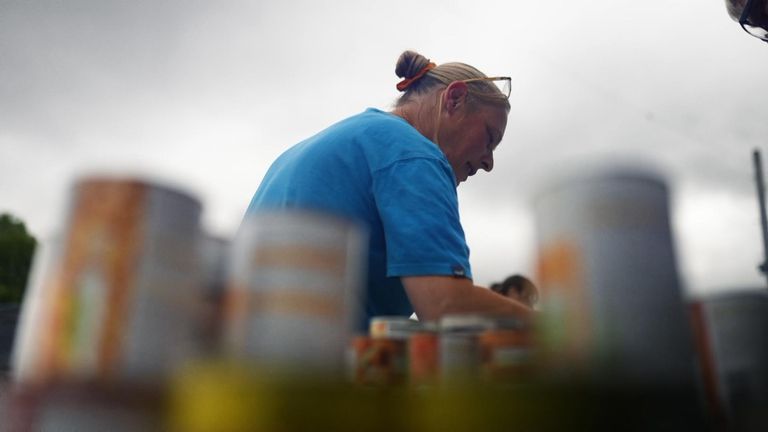Peter Oloya - the Ugandan LRA child soldier who moulded a new future in art
The joy former child soldier Peter Oloya finds in sculpture was first sparked while hunting for clay with his grandmother in northern Uganda - an area that became infamous for the terrifying raids led by the Lord's Resistance Army (LRA) rebel group.

"My grandmother showed me where clay is, what type of clay to be used and why," says the Ugandan artist, who grew up in the village of Lemo Bongolewic in the district of Kitgum.
This was in the early 1980s before much of the population was herded into camps to save them from the attacks and abductions.
Oloya and his late grandmother, Helen Atoo Ocula, would often follow grazing cows as they made a beeline for moist spots under groves of certain large trees.
There was a particular clay called "punu" in Oloya's Acholi language. It was adored by the cows for its minerals - and by Oloya's grandmother because it was perfect for the pots she made for cooking and to store water.
A young Oloya was mesmerised and inspired by how his grandmother's hands transformed the clay into beautiful pots.
He was especially enthralled by the designs she made on the pots using small tools. "It was only much later when I turned to art as a profession that I realised how artistic she was," he says.
Oloya is now one of Uganda's best-known sculptors - and a leading sculpture gallery in London is hosting an exhibition of his work this month.
He is also respected because he survived the horrors of being kidnapped as a child by the LRA, led by Joseph Kony, who is wanted by the International Criminal Court for war crimes and crimes against humanity.
The artist is most famous for his Crowned Crane, a bronze sculpture of the national bird and a gift in 2007 from Uganda to the late British monarch Queen Elizabeth II.
Among African football fans, he is also well-known for making the coveted trophy for the BBC's African Footballer of the Year award, for a decade from 2009.
Oloya currently paints and works mostly in bronze, marble and wood - but his artistic roots lie in the clay he collected with his grandmother from riverbeds in a valley near his village home.
"Pottery is very sculptural, and clay has been part of me since childhood," Oloya tells the BBC.
As a child, Oloya was sometimes mocked for making pottery with his grandmother - because it is seen by his Acholi culture as an occupation for girls and women.
But Oloya could not resist walking by an anthill without scooping some of the fresh, soft clay from it and creating a ball for a slingshot or something else from it.
"Whenever I see it, I intuitively pick up clay and try to make something out of it - for fun, for entertainment," he says.
His first sculpture came out another of his passions - listening to the radio. His father, a police officer based in the capital, Kampala, had sent one home. It had lights on it, which turned from green to yellow to red depending on the volume.
"I loved it so much and, as a child, I used to wonder how little people got in there to talk," Oloya says.
He modelled a radio out of clay, digging out little holes for the indicator lights. He filled them with fireflies, which glow in the dark.
But his childhood was marred by years of conflict in northern Uganda, as government forces battled the LRA fighters, who are notorious for killings, raping and abducting children to be either fighters or sex slaves.
Like hundreds of thousands of people, Oloya was forced out of his home into an internally displaced camp (IDP) set up by the government.
And then, when he was 11, he was abducted by the LRA when his family had ventured back to their garden to harvest sesame seeds to make into a nutritious paste as there were not enough food rations in the camp.
He was beaten up, separated from his mother and with other captive boys taken deep into the bush.
They kept moving around to avoid government troops, the rebels forcing their captives to become boy soldiers.
During that time, Oloya turned to his beloved clay as therapy to ease the horrors he was facing - something he still finds hard to talk about.
He would dig out clumps of clay from the many termite mounds that littered the bush where he was being held.
"I suddenly realised I was doing art, even there in the bush," he says.
For months he thought his mother was dead until a new abductee told him that she was alive - and that is when he decided he needed to get away.
Oloya managed to escape after 18 months. And art became his refuge.
In 2004, he graduated from Makerere School of Fine Art - paying his way by DJing at night and selling toys that he had been making since he was a child.
Oloya believes in the power of art to change people's lives.
After graduating from art school, he returned to the IDP camps in northern Uganda to give art lessons, nurture talent and also put on exhibitions in Kampala.
Profits from any art sales were shared out.
The camps are now closed and people in northern Uganda have been able to return home. But his community-based organisation still operates - and he is setting up a museum of Acholi art and culture in his village.
For his first international solo exhibition at London's Pangolin Gallery, Oloya has created a new body of work that focuses once again on themes that most interest him: the concept of beauty, the play between modernity and culture, and the environment and climate.
Fault is a bronze piece made from the impression of cracked earth. Unless you look carefully, you might miss the small, flailing human figure that has fallen into one of the cracks - or fault lines.
Oloya's message is blunt: "Climate change, global warming - it's our fault and it's killing us."
A companion piece is a bronze sculpture of a crying child. It offers more hope - because the child is also clutching a green seedling in one hand.
"We have to stop thinking of the planet as Mother Earth, which is there to just provide for us," Oloya says.
"Instead, we need to think of the planet as a distressed child, who is asking to be carried, who is asking for our help."
Another striking piece - which is different to his usual work - is a woman's traditional dress that Oloya has made from bark cloth. Attached to the bodice are old mobile phone keyboards.
Oloya uses them as symbols of modernity and plastic waste from outside Africa, which contrast vividly with the organic bark cloth that comes from inside the continent.
"Much of our environment in Africa is not made in Africa. It is brought in and is rotting in Africa," says the artist.
"But I put the dead phones on the dress to give people hope - we can recycle things, we can reuse things."
Oloya also explores the theme of modernity in a series of different sized and shaped gourds, the woody fruit of the calabash trees.
He has burnt on to the surface of the gourds African decorative patterns.
At first glance they look like the calabash used in many villages to store milk, oil or water. But on closer inspection, you can also see the logos of the giant global corporations that now dominate the drinks market in most African countries.
"I love art," Oloya says "because it's given me another language - to spark conversations."
-bbc







